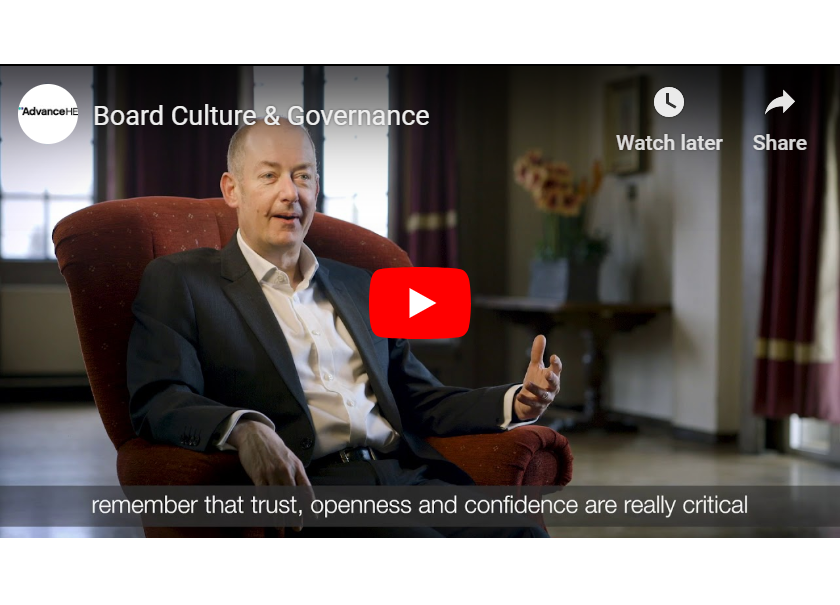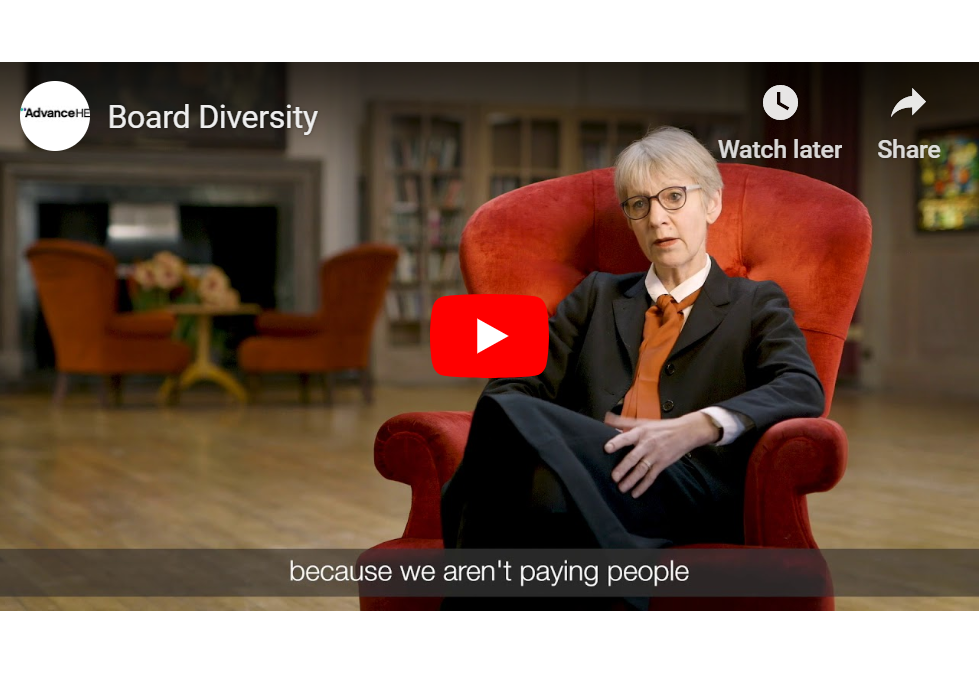
What contributes to an effective board culture, how can boards ensure that they are in touch with the experiences of students studying in their universities, and how can boards improve their diversity? These are some of the questions explored in three specially commissioned films on the theme of good governance. The project was overseen by Advance HE’s Governance Associate, Mary Joyce and include contributions from Chris Sayers, Dame Shirley Pearce, Stuart Palmer, Bill Rammell, Sana Iqbal, Irene Birrell and Paul Greatrix. They are intended to prompt discussion and further debate within universities on key governance topics and will be used to support Advance HEs’ governor development programmes.
These films build on a 2015 governor dialogues project undertaken by Mary Joyce, outputs from which can be found below.
Board culture and good governance
This film explores a number of key elements that help make a board effective as well as exploring how boards create a culture that facilitates good governance, creates healthy debate and fosters diversity of thought

The student experience
This film explores what boards are doing to ensure they understand students’ experience of studying in their university and how they respond to students’ needs.

Board diversity
This film explores some of the dilemmas and solutions in improving the diversity of university boards.

The 2015 Governor Dialogue series
The alchemy of the board
To achieve effective governance, Chris Sayers highlights the importance of a governing body’s emotional intelligence. This includes having the ‘right’ governors. In anticipating the future landscape of higher education, Sayers draws on his experience of the privatisation of British Telecom. He notes the need to match the capabilities of a governing body with the operating environment. A changed operating environment requires different skills. If a governing body is to operate effectively it is important to establish a culture of trust and loyalty. When interviewing new independent governors the focus is primarily on determining if the individual is likely to fit the culture and philosophy of the governing body. Finally, the sport of rowing is used to highlight differences between the roles and responsibilities of members of the governing body and the executive.
Rethinking university governance and purpose
The conversation is against the backdrop of the impending retirement of a long-standing vice-chancellor and the commencement of external review of the governing body’s effectiveness. The dialogue discusses current practice, but also how aspects of the Council’s structure and work may evolve. The Council currently has 32 members. This number in future may be reduced. The Council meets six time a year, with time also spent at away days. Meetings of the Council include time set aside for normally two strategic presentations and discussions. Committees carry out much of the detailed work of the governing body.
However, the Chair takes care to ensure key strategic decisions are made at Council, and not at committee. Looking ahead governors are seeking to become more closely involved in strategy, and in particular the different longer-term strategic options for securing the University’s future. Discussion of the process of choosing the next vice chancellor notes the establishment of small and representative panel to oversee stakeholder consultations and the use of three questions to explore the views of each group. Not only were the responses judged to be helpful, but also as important was the process.The dialogue concludes by briefly considering possible differences in governance with newer universities. A suggestion is the University of Bristol may have been better at blending collegiality and business professionalism.
Leading the board through challenge and change
Tony Brian suggests no form of governance can guarantee correct decisions every time, but that good governance should mean there are more correct decisions than if there wasn’t good governance. He sees constructive challenge as questioning which encourages the proposer to develop their thinking, and avoids the individual leaving the meeting feeling they have been personally criticised or belittled. The decision-making of the Court include the use of a ‘pathfinder’ approach. This is a two-stage process, allowing new ideas to be explored and developed. It avoids the risk of the governing body being placed in the position of having to take or leave a proposal. In short it creates space for discussion and development. Stage one of the pathfinder approach involves the submission and discussion of a concept paper.
The paper contains an initial assessment and associated financials. Discussion at this stage allows members of the Court to offer inputs from their own knowledge and expertise. If the idea is supported in principle, stage two of the pathfinder involves the development and discussion of a detailed paper to allow a decision to be made. The dialogue also touches on concerns as to the risks associated with smaller boards and groupthink, and about the remuneration of chairs and governors. Remuneration is rejected on the basis that it could comprise the individual’s independence
Creating a board fit for purpose
The backdrop to the conversation is a period of change at the University and for the governing body. The appointment of a new vice-chancellor triggered the changes. A new institutional strategy raised the question of whether the University’s governance would be able to support and accommodate a faster pace of change? Following a review, the size of the board was reduced, and a number of committees abolished: as a result ‘everybody sees everything’. In parallel to these changes, the frequency of board meetings was increased to monthly. In determining membership of the governing body a clear distinction was made between the Board and the role of the Court – the forum for stakeholder representation.
Changes were made to how the Court operated, so it became a more effective forum for stakeholders. External advice on who should sit on the Board suggested the need to appoint individuals who understood ‘the core product of higher education enterprise’, and who could align themselves with the organisation’s values. There was also a need to turn ‘a group of individuals into a team of governors’. The importance of mutual trust and respect between governors and the executive is stressed, and the relationship judged to work best when there is clear understanding of the different roles. Achieving a common understanding is important, and spending time to create the ‘soft space for board relationships to blossom’ is an important part of relationship building.
Good governance and success
Against the backdrop of revised codes of practice and failure of governance in other sectors, Chris expresses the concern that nobody has properly defined what governance is, or distinguished between governance and management. He also notes that while the University is successful he is not sure it is down to the governing body. His key ingredients for good governance are communication, by which he means ensuring governors have the information they require to be effective, having the right people as governors and a structure that allows governors to contribute on the Council. The Council meets three or four times a year, and he suggests that a three-year term of membership is too short once it is recognised that it takes between three and four years for a new governor to understand what is going on.
The University’s experience of using external advertising has been disappointing, and doubts are expressed as to whether advertising is likely to bring forward individuals with the qualities that the Council is seeking. The knowledge and experience sought from prospective members of Council include organisational decision-making at a relatively high level, the ability to communicate effectively and general intelligence. A majority of the University's Council members are drawn from the county of Yorkshire. A key role of the Council is agreeing a policy framework for the executive to action and the subsequent monitoring of the impact of the actions taken. Governors should not become involved in undertaking the tasks themselves. If they do, because they think the executive isn’t competent, they should change the executive.
A baptism of fire
The dialogue describes the journey from being an institution where neither the governing body or the senior management team were judged to be ‘fit-for-purpose’, to the appointment of a new vice chancellor and new members of the governing body. The dialogue highlights the risk of governors acting as representatives when they are drawn from a specific constituency. The role of a nominations committee in rigorously evaluating all potential new members of the governing body to ensure they have the required knowledge and skills is stressed. The dialogue also discusses the period before the new vice chancellor took up post, and how the chair of the governing body worked as a ‘critical friend’ with the then deputy principal who was the acting head of the institution. Although the dialogue indicates further changes are required, Juliet Williams believes that the board is beginning to add value.
Appointing a new Vice-Chancellor
This dialogue focuses on how the University went about appointing a new vice-chancellor, but also offers a number of observations about higher education governance. The process of appointing a new head of institution involved the establishment of an appointing committee (with equal representation from the council and senate), and extensive consultation with the whole of the university. As Towie acknowledges ‘it was a very extended process.’ Readers with a particular interest in how to appoint a vice-chancellor may also wish to refer to Governor dialogue No.2, which outlines the process used by the University of Bristol.
With a commercial background, but also with extensive experience of chairing the board of a large charity, Towie offers a number of interesting comments on university governance. Towie suggests ‘it is as if the historic governance of a university via its senate has had superimposed on it a superstructure of charity governance....’, whose purpose is to protect public money and act as an overseer. There is a risk that excessive attention is given to governance, meaning the real purpose of a university is forgotten.
In her closing comments, Towie raises the question of a council needing to have members who are ‘external experts on higher education’. She sees a contrast between members of commercial board having connected knowledge with the company’s industry and the absence of such individuals on many university boards.
Ethnic and cultural diversity: a personal reflection
Ranjit Sondhi chaired a summit for us that aimed to develop practical steps towards supporting Black and Minority Ethnic (BME) staff to realising their potential and ensuring higher education institutions benefit from the diversity of talent in the academic and professional workforce. This is the talk that he gave to open the session. We have included it as part of our Governor Dialogue series, because it makes important arguments around valuing diversity and difference and shaping institutional cultures that encourage participation.